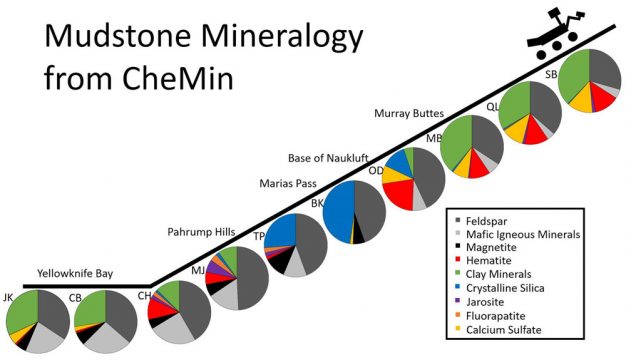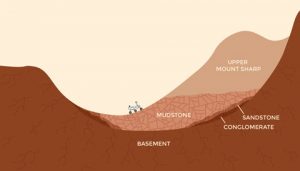Curiosity scientists have tracked the transformation of Gale Crater’s environment as it became more, then less, acidic over millions of years.
NASA’s Mars Science Laboratory (a.k.a. the Curiosity rover) has been trundling across the floor of Gale Crater for four years now. It went to the Red Planet to look for evidence of ancient habitable conditions, locked up in the crater’s rocks. Particularly entrancing to scientists were the sediment layers in the crater’s 5.5-km-tall (18,000-ft-tall) mountain, known as both Aeolis Mons (formally) or Mount Sharp (informally). Traversing those built-up layers is providing a series of geological snapshots of how the Martian environment changed over time in this equatorial crater.
Step by rover step, mission scientists have been piecing together a picture of the ancient Martian environment and its evolution. Presented December 13th at the annual American Geophysical Union meeting in San Francisco, that picture looks like this:

NASA / JPL-Caltech
This diagram shows the compositions of mudstones (formed in water) at 10 different drill sites. Each pie chart displays the minerals in a drill sample. From bottom to top of the diagram, the samples cover 200 meters (700 ft) of vertical elevation. They’re not a straight stratigraphy, however: except for the last four samples (Oudam, Marimba, Quela, and Sebina), scientists drilled on an individual this-rock-looks-cool basis. The last four sites are more methodical, each separated by 25 meters of elevation.
The rock samples show a transition from less acidic to slightly more acidic conditions, then back again. The green pie slices at the beginning and end indicate clays, which form in fairly neutral water. In the middle, the mineral jarosite (purple) appears, which forms in acidic water.
But the early, Yellowknife Bay clays (lower left) are different from the Murray Buttes clays (upper right). They contain different metals that formed with different levels of oxygen around — probably somewhere in the surrounding plains before flowing down into Gale and becoming part of the mudstones. These oxidizing levels were higher for the Murray Buttes rocks. There’s also a lot more basaltic volcanic rock (light grey) in Yellowknife Bay.

NASA / JPL-Caltech
In the Murray formation, Curiosity detected an uptick in the salt calcium sulfate, suggesting the water that the mudstone coalesced in was more concentrated (perhaps because it was evaporating away, as the additional discovery of boron suggests). The amount of salt is comparable to what you’d get from evaporating a glass of seawater, team member John Grotzinger (Caltech) said during the press conference.
The team previously dated the Cumberland (CB) sample from Yellowknife Bay to be roughly 4 billion years old. The scientists don’t have precise ages for the other samples, but on Earth, an elevation change of 200 meters would correspond to tens to hundreds of millions of years. Since Mars doesn’t have things like plate tectonics or other major geologic upheavals in this region, this range is probably a conservative estimate of how much geologic time Curiosity has climbed through. Thus, the environmental changes in these drill sites probably happened on time scales of at least tens of millions of years.
Despite the change in acidity, all samples suggest conditions friendly to microbial life. Curiosity isn’t designed to find that life, but the presence of amorphous silica (blue) excites the team because it forms quickly and is good at trapping things before water can break them down. Amorphous silica is the most common repository of fossils on Earth.
Although the drilled rocks are all mudstones, that doesn’t necessarily mean a lake was present in Gale across this entire geologic period. Veins in rocks spotted by Curiosity likely formed when groundwater flowed into cracks in the mudstones. The crater sits on the dichotomy boundary, the edge between the planet’s southern highlands and northern lowlands, and is the lowest point for 1,000 km. So there would have been plenty of water flowing that way, potentially for a long time, even if surface water and precipitation were intermittent.
You can read more about the results in the NASA/JPL/Los Alamos National Lab press release, and in the archived webcast of Tuesday’s press conference.
Learn more about Mars in our special issue Mars: Mysteries and Marvels of the Red Planet.
 2
2









Comments
Robert-Casey
December 15, 2016 at 11:27 am
If the Sun was fainter (around 70% of today) 4 billion years ago, then if we have trouble having Earth warm enough for water in oceans and land, then this problem should be even more difficult on Mars back then. All the water would be frozen. Maybe an ocean under a frozen ice sheet planet wide?
You must be logged in to post a comment.
Wayne-Wooten
December 15, 2016 at 1:09 pm
Remember Mars atmosphere was much thicker then, with more carbon dioxide allowing for better trapping of the sunlight and heat. Certainly true on earth too. Had we retained all of our primitive atmosphere, we would be Venus, not earth. The emission of greenhouse gases from volcanism continues here, but on a greatly reduced scale, and probably even more so for smaller, less massive and dense Mars.
You must be logged in to post a comment.
You must be logged in to post a comment.